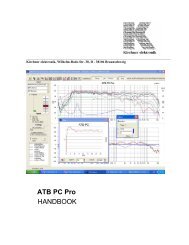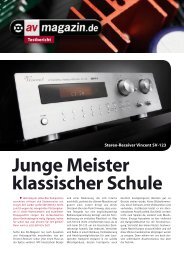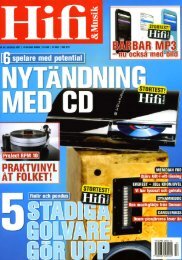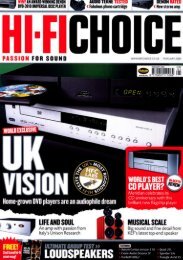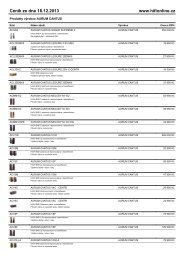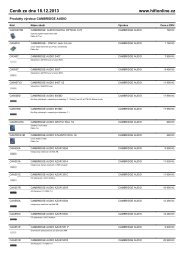Test Lyngdorf Audio SDAI2175 - HiFi World ... - Hifi on Line
Test Lyngdorf Audio SDAI2175 - HiFi World ... - Hifi on Line
Test Lyngdorf Audio SDAI2175 - HiFi World ... - Hifi on Line
You also want an ePaper? Increase the reach of your titles
YUMPU automatically turns print PDFs into web optimized ePapers that Google loves.
GROUP TEST<br />
SWITCH-MODE SEMI-DIGITAL:<br />
LYNGDORF AUDIO SDAI 1275 £1,095<br />
Formerly TacT, Danish<br />
brand <str<strong>on</strong>g>Lyngdorf</str<strong>on</strong>g> <str<strong>on</strong>g>Audio</str<strong>on</strong>g>’s<br />
SDAI 1275 is a fully balanced,<br />
remote c<strong>on</strong>trolled,<br />
switch-mode integrated<br />
amplifier which has no<br />
relays or fuses in its signal path. It<br />
measures 450x361x100.6mm and<br />
weighs 15.5kg. SDA is an abbreviati<strong>on</strong><br />
for Semi Digital Amplifier<br />
which designates it separately from<br />
<str<strong>on</strong>g>Lyngdorf</str<strong>on</strong>g> <str<strong>on</strong>g>Audio</str<strong>on</strong>g>’s higher-cost True<br />
Digital Amplifiers (TDA). <str<strong>on</strong>g>Lyngdorf</str<strong>on</strong>g><br />
say that “the SDAI 2175 is a less<br />
complex design (than TDA) which<br />
relies <strong>on</strong> analogue inputs to generate<br />
the digital switching at the<br />
output. The output stage operates<br />
by pulse-width-modulati<strong>on</strong> (PWM)<br />
at a very high switching rate and<br />
c<strong>on</strong>stant voltage. This is similar to<br />
the operating principle of the (highend)<br />
TacT Millennium (TDA), but<br />
while the Millennium c<strong>on</strong>verts the<br />
digital informati<strong>on</strong> directly from the<br />
digital source, the SDAI 2175 utilizes<br />
analogue inputs to generate PWM<br />
switching at the output”.<br />
<str<strong>on</strong>g>Lyngdorf</str<strong>on</strong>g> use PWM because<br />
they claim that the “SDA 2175<br />
generates 75% less heat than<br />
a Class AB amplifier of<br />
similar power.<br />
Heat is<br />
the<br />
greatest<br />
c<strong>on</strong>tributor to<br />
comp<strong>on</strong>ent ageing.<br />
Capacitors in particular<br />
are pr<strong>on</strong>e to heat damage over<br />
time”. The quoted specificati<strong>on</strong><br />
for the SDAI 1275 is impressive<br />
- when compared with those from<br />
similarly priced hi-fi integrated<br />
amplifiers - with a power output<br />
of 220W/8ohms and 375W/4ohms.<br />
The company says that the SDAI<br />
1275 uses a digitally c<strong>on</strong>trolled<br />
analogue attenuator, and the volume<br />
is c<strong>on</strong>trolled with 0.1 dB steps<br />
(over a 100dB range). Instrumentgrade<br />
dual gold relays are used<br />
for input switching that <str<strong>on</strong>g>Lyngdorf</str<strong>on</strong>g><br />
claims are normally <strong>on</strong>ly used in<br />
expensive measurement equipment<br />
“for high linearity and low losses”.<br />
The <str<strong>on</strong>g>Lyngdorf</str<strong>on</strong>g> can also adjust the<br />
attenuati<strong>on</strong> to each input by 6dB to<br />
optimize signal to noise ratio.<br />
The seven inputs (<strong>on</strong>e is XLR<br />
balanced) can be individually adjusted<br />
in 0.1 dB steps, while the display is<br />
programmable to name the input.<br />
The transformer is a 650VA Toroid-<br />
Holmgren design for which <str<strong>on</strong>g>Lyngdorf</str<strong>on</strong>g><br />
state that it “is particularly resistant<br />
to mechanical hum”. Internally<br />
it uses capacitors for its power<br />
supply regulati<strong>on</strong> rated at over<br />
40,000 micro-Farads and a separate<br />
board for the IEC mains input with<br />
mains filtering. Further SDAI 1275<br />
features include, two preamp outputs<br />
(<strong>on</strong>e balanced), individual balance<br />
adjustment for each input with 0.1<br />
dB steps, channel balance + - 0.05<br />
dB “at any level down to -80 dB”,<br />
3.5mm jack c<strong>on</strong>nector trigger output<br />
for c<strong>on</strong>trol over additi<strong>on</strong>al SDA 2175<br />
power amplifiers and RS 232<br />
c<strong>on</strong>necti<strong>on</strong>s for software<br />
modificati<strong>on</strong>s.<br />
Build<br />
quality<br />
at reducing magnetic interference<br />
which can detrimentally affect sound<br />
quality. Overall the visual design of<br />
the <str<strong>on</strong>g>Lyngdorf</str<strong>on</strong>g> is unpretentious yet<br />
discerning and discretely attractive,<br />
which is what I prefer as it gives l<strong>on</strong>g<br />
term owner satisfacti<strong>on</strong>.<br />
SOUND QUALITY<br />
On Ligeti’s ‘Trio For Violin, Horn And<br />
Piano’ the <str<strong>on</strong>g>Lyngdorf</str<strong>on</strong>g> was fascinating,<br />
as it was able to illuminate deep<br />
into the rather quiet but dynamically<br />
superb recorded musical structure<br />
with an uncomm<strong>on</strong> ability compared<br />
to the other amplifiers <strong>on</strong> test. The<br />
whole of the Ligeti piece was<br />
opened out with great<br />
insight and with<br />
stunning<br />
musical<br />
timing,<br />
again the<br />
best of the group,<br />
outdoing the superb<br />
Sugden. The musical separati<strong>on</strong><br />
was just effortless for an amplifier<br />
<strong>on</strong> of this price and the t<strong>on</strong>ality<br />
the<br />
<str<strong>on</strong>g>Lyngdorf</str<strong>on</strong>g> is<br />
excepti<strong>on</strong>al for the<br />
asking price with a superslick<br />
level of finish and attenti<strong>on</strong><br />
to design detail that is usually seen<br />
in much more expensive products.<br />
For instance the thick faceplate has<br />
a beautifully machined chamfered<br />
opening which frames the display and<br />
c<strong>on</strong>trol butt<strong>on</strong>s, while the power<br />
<strong>on</strong>/off butt<strong>on</strong> has its own recessed<br />
machined opening. The heatsinks <strong>on</strong><br />
either side are also nicely machined<br />
types which are smooth to the touch<br />
instead of razor-sharp.<br />
The SDAI 2175 casework utilises<br />
CNC machined aluminium including<br />
its chassis which is differentiated<br />
from the typical steel chassis, and<br />
occasi<strong>on</strong>al aluminium outer panels<br />
of the norm. The visible fixings <strong>on</strong><br />
the top panel are recessed hexhead<br />
types which are preferable<br />
to the typical cross-head screws.<br />
Additi<strong>on</strong>ally the base plate uses<br />
4mm thick aluminium sheet, <strong>on</strong>ce<br />
again instead of steel which is better<br />
was excellent with an extremely<br />
accomplished timbre – where it was<br />
also completely in time with the rest<br />
of the musical structure. The violins<br />
had a very pleasing timbre with<br />
w<strong>on</strong>derful extensi<strong>on</strong> and expressi<strong>on</strong>.<br />
The violin phrasing was particularly<br />
good. The <str<strong>on</strong>g>Lyngdorf</str<strong>on</strong>g> handled the<br />
first crescendo very well with an<br />
unnerving sense of c<strong>on</strong>trol.<br />
The <str<strong>on</strong>g>Lyngdorf</str<strong>on</strong>g> had a completely<br />
neutral presentati<strong>on</strong> in comparis<strong>on</strong><br />
with the other amplifiers <strong>on</strong><br />
test when listening to ‘Dreams’<br />
by Fleetwood Mac. The musical<br />
timing - c<strong>on</strong>sidering the gelling<br />
together of the different vocal and<br />
instrumental strands as a cohesive<br />
musical structure, to form a wellbalanced<br />
and more natural pace and<br />
tunefulness - was simply first-rate.<br />
The <str<strong>on</strong>g>Lyngdorf</str<strong>on</strong>g> displayed excellent<br />
bass dexterity and was very good<br />
with the vocals, where there was no<br />
sense of discernible strain or high<br />
frequency stridency in the female<br />
vocals. On ‘Never Going Back Again’<br />
the <str<strong>on</strong>g>Lyngdorf</str<strong>on</strong>g> was able to reproduce<br />
www.hi-fiworld.co.uk NOVEMBER 2005 HI-FI WORLD 21
GROUP TEST<br />
"like the Sugden, it’s a genuinely<br />
special sounding amplifier, although<br />
for quite different reas<strong>on</strong>s!"<br />
a w<strong>on</strong>derful vocal from Lindsey<br />
Buckingham. There was a really nice<br />
delicacy and multilayered sophisticati<strong>on</strong>,<br />
and it seemed eerily in the<br />
room.<br />
Guitar timbre and expressi<strong>on</strong>,<br />
while not as three-dimensi<strong>on</strong>al as the<br />
Sugden, was still extremely precise<br />
in its ability to slice through the air.<br />
This reproducti<strong>on</strong> of the guitar and<br />
vocals also reinforced the <str<strong>on</strong>g>Lyngdorf</str<strong>on</strong>g>’s<br />
excellent musical timing ability as it<br />
was inherently cohesive to the s<strong>on</strong>gs<br />
structure. On ‘D<strong>on</strong>’t Stop’ the whole<br />
musical structure was beautifully<br />
revealed and had the <str<strong>on</strong>g>Lyngdorf</str<strong>on</strong>g>’s<br />
exacting musical timing intact where<br />
every vocal, element, strand and<br />
instrumental int<strong>on</strong>ati<strong>on</strong> was superbly<br />
executed and free flowing. Individual<br />
aspects such as vocals were excellent,<br />
while the instrumental timbre had<br />
good definiti<strong>on</strong>. Bass was dextrous<br />
and also well defined while the treble<br />
was able to open out the music into<br />
a widescreen dimensi<strong>on</strong>.<br />
Steve Steven’s ‘Flamenco A Go<br />
Go’ was thrilling; all the elements<br />
gelled to produce stunning musical<br />
timing. Bass was again excellent,<br />
which gave a lift to the lower mid<br />
while not being unnaturally extended<br />
as to dislocate itself from the rest<br />
of the music. This upper bass/lower<br />
midrange frequency quality helped<br />
to provide rhythmic thrust and<br />
enjoyment through Steve Steven’s<br />
rocket-ship rush of acoustic guitar<br />
melodies. On ‘Our Man In Istanbul’<br />
there was the recurring talent of the<br />
<str<strong>on</strong>g>Lyngdorf</str<strong>on</strong>g> in enabling stunning instrumental<br />
and vocal separati<strong>on</strong>. The<br />
gorgeously sexy vocal from Azam<br />
Ali was especially good with the<br />
<str<strong>on</strong>g>Lyngdorf</str<strong>on</strong>g>’s separati<strong>on</strong> ability as there<br />
was a sense of openness not available<br />
<strong>on</strong> the other amplifiers, where her<br />
voice was deliciously free-flowing and<br />
super-clear without a single hint of<br />
high-frequency glare or harshness.<br />
The <str<strong>on</strong>g>Lyngdorf</str<strong>on</strong>g>’s musical timing<br />
abilities also took the complexities of<br />
‘Our Man In Istanbul’<br />
in its stride – making<br />
for a neutral yet<br />
thrilling ride.<br />
CONCLUSION<br />
Like the Sugden, this<br />
is a genuinely unusual<br />
and special sounding<br />
amplifier, although<br />
for quite different<br />
reas<strong>on</strong>s! It is initially<br />
underwhelming, but<br />
due to its massive<br />
power output it was<br />
able to provide an<br />
excellent grip and<br />
drive to the differing<br />
demands of all the<br />
music used. It has<br />
an eerie sense of<br />
c<strong>on</strong>trol and superlative<br />
musical timing<br />
that never stifled<br />
its t<strong>on</strong>al resolving<br />
ability. As such it was<br />
very special with<br />
completeness in<br />
the most important<br />
aspects of the musical<br />
structure - such as<br />
outstanding instrumental<br />
and vocal<br />
separati<strong>on</strong> which was<br />
surgically unravelled<br />
but never clinical.<br />
The <str<strong>on</strong>g>Lyngdorf</str<strong>on</strong>g> is not a<br />
sugary sounding device<br />
(unlike the Marantz,<br />
for example), although<br />
it remained resolutely<br />
musical in a neutral,<br />
unflappable and dynamic manner.<br />
Build quality is equally brilliant for<br />
the asking price while the visual<br />
design is my favourite of the group<br />
as it expresses a butt<strong>on</strong>ed-down<br />
discreti<strong>on</strong> that can <strong>on</strong>ly come from<br />
first-class craftsmanship. In some<br />
respects, this product sounds like<br />
‘superfi’; its refinement, subtlety,<br />
unflappability and sheer c<strong>on</strong>trol are<br />
remarkable, and many will instantly<br />
The distorti<strong>on</strong> behaviour of this amp<br />
is influenced by its tightly limited<br />
bandwidth. Harm<strong>on</strong>ics of higher<br />
frequencies are curtailed, meaning<br />
past 6kHz or so distorti<strong>on</strong> starts to<br />
go down, not up. At 6kHz though,<br />
where sec<strong>on</strong>d and third harm<strong>on</strong>ics fall<br />
within the bandwidth of the output<br />
filters, distorti<strong>on</strong> at low levels of a<br />
few watts measured just 0.003% into<br />
8ohms, rising to 0.007% into 4ohms,<br />
third harm<strong>on</strong>ic predominating in bridge<br />
c<strong>on</strong>diti<strong>on</strong>s, as sec<strong>on</strong>d cancels. Near full<br />
output (30V) the worst case result was<br />
0.02%, sec<strong>on</strong>d and third harm<strong>on</strong>ic, into<br />
4ohms, a low value. In the midband,<br />
distorti<strong>on</strong> levels were much the same,<br />
so this amplifier is c<strong>on</strong>sistent in its<br />
behaviour, which means the distorti<strong>on</strong><br />
spectrum is not c<strong>on</strong>stantly changing,<br />
always a good sign. The SDAI 2175<br />
interestingly possesses a better<br />
distorti<strong>on</strong> performance than c<strong>on</strong>venti<strong>on</strong>al<br />
amplifiers.<br />
This is a bridge amplifier, like<br />
most ‘digital’ switching amps. It has<br />
no problem swinging massive output,<br />
no less than 220W into 8ohms<br />
and 324W into 4ohms, whilst<br />
barely getting warm, due to high<br />
efficiency. There’s 35V d.c. <strong>on</strong><br />
both output lines, but protecti<strong>on</strong><br />
circuits guard against damage<br />
from shorts to ground or any differential<br />
output offset that would<br />
threaten the loudspeaker. It is not<br />
d.c. coupled throughout though;<br />
tests showed input d.c. did not<br />
affect output c<strong>on</strong>diti<strong>on</strong>s.<br />
Frequency resp<strong>on</strong>se of digital<br />
amps like this is, in theory, load<br />
dependent, because of the output<br />
VERDICT<br />
LYNGDORF AUDIO<br />
SDAI 1275 £1,095<br />
<str<strong>on</strong>g>Lyngdorf</str<strong>on</strong>g> <str<strong>on</strong>g>Audio</str<strong>on</strong>g><br />
+44 (0)8709 100 100<br />
www.lyngdorfaudio.co.uk<br />
FOR<br />
- design and build<br />
- neutral yet engaging<br />
- stunning musical timing<br />
- massive power<br />
)<br />
MEASURED PERFORMANCE<br />
AGAINST<br />
- takes time to appreciate<br />
filters. However, the SDAI 2175 varied<br />
little between 4ohms and 8ohms,<br />
looking flatest <strong>on</strong> the lower value. The<br />
upper -1dB bandwidth limit is 27kHz;<br />
the lower limit is 1Hz.<br />
Sensitivity is very low at 1V<br />
maximum. I d<strong>on</strong>’t understand this, as<br />
most sources give 0.5V or thereabouts,<br />
so it’s far too low; <strong>on</strong>ly CD gives more.<br />
External ph<strong>on</strong>o stages, tuners and such<br />
like must give 1V to match this amp<br />
- and few do.<br />
This is a heavily engineered<br />
amplifier in all senses, more so than<br />
usual. It measures extremely well,<br />
except for low sensitivity which will<br />
make matching difficult. NK<br />
Power<br />
220watts<br />
CD/tuner/aux.<br />
Frequency resp<strong>on</strong>se 1Hz- 27kHz<br />
Separati<strong>on</strong><br />
88dB<br />
Noise (IEC A)<br />
107dB<br />
Distorti<strong>on</strong> 0.003%<br />
Sensitivity<br />
1Vdc offset<br />
8/21mV<br />
www.hi-fiworld.co.uk NOVEMBER 2005 HI-FI WORLD 23<br />
£<br />
Remarkably sophisticated and powerful<br />
amplifier that’s subtle but infectiously<br />
musical too.
CONCLUSION<br />
C<strong>on</strong>clusi<strong>on</strong><br />
These four amplifiers were<br />
all different, yet all are<br />
very capable performers<br />
and as such this should<br />
be celebrated. Both the<br />
lower powered Sugden<br />
and Minimax designs had no trouble<br />
driving the ribb<strong>on</strong> tweetered Aurum<br />
Cantus Leisure 3SE speakers to<br />
what I c<strong>on</strong>sider very loud levels in<br />
my 6.5x4.5m listening room. When<br />
Noel Keywood measured them he<br />
said, “sensitivity was low at 82dB but<br />
this wasn’t surprising as the ‘speakers’<br />
impedance is very high, measuring<br />
12ohms overall. It (the Aurum<br />
Cantus) is a very light load, even for<br />
a valve amp. But does need ‘power’<br />
(volts) to go loud”.<br />
When correctly load matched,<br />
the Class A transistor Sugden A21a<br />
had useful power and ably gripped<br />
the speakers to produce the best<br />
instrumental timbre of the whole<br />
group. Additi<strong>on</strong>ally it had excellent<br />
resoluti<strong>on</strong> which was interesting,<br />
allied to a generally neutral but<br />
engaging sound quality that I really<br />
enjoyed. The Sugden’s sound<br />
quality can be described as very<br />
linear, tightly organised yet soulful<br />
which makes it a bit of a chimera<br />
of an amplifier! It does run hot<br />
though, and thus I would treat it as<br />
a valve amplifier allowing between<br />
thirty to sixty minutes ‘warm’ up<br />
before use and then switching off<br />
afterwards. The Sugden did not have<br />
the best bass extensi<strong>on</strong>, but the<br />
more complex and important bass<br />
dexterity was nicely aligned to the<br />
rest of the higher frequencies to<br />
produce its linear but tuneful sound.<br />
It didn’t always have the best vocal<br />
timbre but because it was so well<br />
balanced and musically well-timed, in<br />
isolati<strong>on</strong> this is not noticeable. The<br />
Sugden is especially well-built but<br />
not flashy in appearance and though<br />
it didn’t have a remote c<strong>on</strong>trol, this<br />
was not an issue for me. I loved it<br />
because it’s such a simple, unrec<strong>on</strong>structed,<br />
unalloyed music maker.<br />
The switch-mode Semi Digital<br />
<str<strong>on</strong>g>Lyngdorf</str<strong>on</strong>g> SDA 1275 was also really<br />
accomplished, and pure joy to use<br />
and listen to. It has an unflappably<br />
neutral sound quality that was<br />
always in c<strong>on</strong>trol of the demanding<br />
frequency extremes from the<br />
different music used. This neutrality<br />
also meant that the <str<strong>on</strong>g>Lyngdorf</str<strong>on</strong>g> is not<br />
smooth, lush or sweet and that is a<br />
good thing as this ability is important<br />
for preserving the individuality of<br />
the music used. And for listeners<br />
who enjoy a wide, dynamic and<br />
manifold selecti<strong>on</strong> of music this will<br />
be a prescient quality. The <str<strong>on</strong>g>Lyngdorf</str<strong>on</strong>g>’s<br />
neutrality does not mean it sounds<br />
cold, clinical or even grey as some<br />
percepti<strong>on</strong>s and realities of digital<br />
amplifiers have been in the past – far<br />
from it! Additi<strong>on</strong>ally the <str<strong>on</strong>g>Lyngdorf</str<strong>on</strong>g><br />
had a very cohesive sound with<br />
superlative musical timing which was<br />
a real pleasure to listen to as I could<br />
c<strong>on</strong>centrate through particularly<br />
dense recordings such as Steve<br />
Steven’s ‘Flamenco A Go Go’ where<br />
the <str<strong>on</strong>g>Lyngdorf</str<strong>on</strong>g> had a real flair for both<br />
vocal and instrumental separati<strong>on</strong>.<br />
It is beautifully c<strong>on</strong>structed in a<br />
high-end high-quality manner and<br />
visually, for me at least, offered a<br />
discrete self-c<strong>on</strong>fident visage. This<br />
for me is the sec<strong>on</strong>d star of the<br />
group, self-effacingly musical, subtle<br />
yet exhaustively thorough in the<br />
way it c<strong>on</strong>veys what’s going <strong>on</strong> in a<br />
performance, with an amazing sense<br />
of imperturbability.<br />
The Class A valve Minimax M520<br />
excelled in all the vocal timbres<br />
experienced through the different<br />
recordings used in the test. It has a<br />
good ability with instrumental timbre<br />
also and I was surprised at its musical<br />
timing ability which was rather good.<br />
The build quality and design were<br />
excellent and commendable for the<br />
asking price without even a hint of<br />
hair shirt or ‘rugged/agricultural’<br />
c<strong>on</strong>structi<strong>on</strong>. The Minimax has<br />
a superbly crafted remote and<br />
remotely-c<strong>on</strong>trolled t<strong>on</strong>al flexibility<br />
with its Pentode or Ultra <strong>Line</strong>ar<br />
modes which were very useful – as<br />
they were not superfluous gimmickry<br />
because of the demands of the<br />
different music used necessitated<br />
adjustment.<br />
The Marantz was a surprise as a<br />
Class AB amplifier; it was the most<br />
t<strong>on</strong>ally characterful amplifier in the<br />
group! It was intriguing because it<br />
has a w<strong>on</strong>derful full-bodied nature to<br />
the recordings used and some very<br />
nice vocal timbre was also revealed.<br />
“like the difference between the Beatles<br />
and Beethoven, that’s what happens<br />
when you go from Class A to D...”<br />
It initially sounded more diffuse than<br />
the others and a little underwhelming<br />
but given some patience the Marantz<br />
rewarded the listener with some<br />
stunningly powerful dynamic swings<br />
that could really grip a crescendo<br />
or tempo swing. The Marantz was<br />
never flustered though and always<br />
remained in c<strong>on</strong>trol. The Marantz<br />
is super-slick in c<strong>on</strong>structi<strong>on</strong> with<br />
remote c<strong>on</strong>trol and an excellent<br />
lateral-thinking upgrade path using<br />
more PM-15S1s (or even a highend<br />
PM11-S1) enabling it to be<br />
bi-amped or go into 5.1 multichannel<br />
if desired! For these reas<strong>on</strong>s, it’s by<br />
far the best all rounder in the group,<br />
with a uniformly high standard in<br />
every department from ph<strong>on</strong>o stage<br />
to remote – but it’s less focused <strong>on</strong><br />
s<strong>on</strong>ics.<br />
Overall then – as you’ve probably<br />
surmised – standards were extremely<br />
high, but we’d give the g<strong>on</strong>gs to<br />
the Sugden and <str<strong>on</strong>g>Lyngdorf</str<strong>on</strong>g> for being<br />
brilliant music makers. The amazing<br />
thing is that they sound so different<br />
- like the difference between the<br />
Beatles and Beethoven. That’s what<br />
happens when you go from Class A<br />
to D!<br />
REFERENCE SYSTEM:<br />
Onkyo DV-SP1000E Universal Player (£2,800)<br />
Aurum Cantus Leisure 3SE Speakers (£1,250)<br />
MUSIC:<br />
György Ligeti (Editi<strong>on</strong> 7) ‘Chamber Music’ (1998) CD<br />
Fleetwood Mac ‘Rumours’ (1977/2001) DVD-<str<strong>on</strong>g>Audio</str<strong>on</strong>g><br />
Steve Stevens ‘Flamenco A Go Go’ (2001) DVD-<str<strong>on</strong>g>Audio</str<strong>on</strong>g><br />
www.hi-fiworld.co.uk<br />
NOVEMBER 2005 HI-FI WORLD 27




